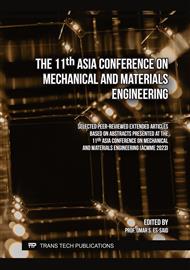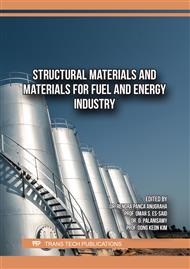[1]
K. Apmann, R. Fulmer, B. Scherer, S. Good, J. Wohld and S. Vafaei, Nanofluid heat transfer: Enhancement of the HTC inside microchannels, Nanomaterials, 12 (2022) 615
DOI: 10.3390/nano12040615
Google Scholar
[2]
Norouzipour, A.; Abdollahi, A.; Afrand, M. Experimental study of the optimum size of silica nanoparticles on the pool boiling HTC of silicon oxide/deionized water nanofluid. Powder Technol. 2019, 345, 728–738.
DOI: 10.1016/j.powtec.2019.01.034
Google Scholar
[3]
Anoop, K.B.; Sundararajan, T.; Das, S.K. Effect of particle size on the convective heat transfer in nanofluid in the developing region. Int. J. Heat Mass Transf. 2009, 52, 2189–2195.
DOI: 10.1016/j.ijheatmasstransfer.2007.11.063
Google Scholar
[4]
Elias, M.; Miqdad, M.; Mahbubul, I.; Saidur, R.; Kamalisarvestani, M.; Sohel, M.; Hepbasli, A.; Rahim, N.; Amalina, M. Effect of nanoparticle shape on the heat transfer and thermodynamic performance of a shell and tube heat exchanger. Int. Commun. Heat Mass Transf. 2013, 44, 93–99.
DOI: 10.1016/j.icheatmasstransfer.2013.03.014
Google Scholar
[5]
Ding, Y.; Chen, H.; He, Y.; Lapkin, A.; Yeganeh, M.; Šiller, L.; Butenko, Y.V. Forced convective heat transfer of nanofluids. Adv. Powder Technol. 2007, 18, 813–824.
DOI: 10.1163/156855207782515021
Google Scholar
[6]
Vafaei, S.; Yeager, J.A.; Daluga, P.; Scherer, B. Forced Convection Nanofluid Heat Transfer as a Function of Distance in Microchannels. Materials 2021, 14, x
DOI: 10.3390/ma14113021
Google Scholar
[7]
Sundar, L.S. Experimental study on the thermophysical properties, heat transfer, thermal entropy generation and exergy efficiency of turbulent flow of ZrO2-water nanofluids. Alexandria Engineering Journal, 2023, 65, 867-885.
DOI: 10.1016/j.aej.2022.10.001
Google Scholar
[8]
Pourpasha, H., Heroes, S.Z., Mohammadpourfard, M. (2023). The effect of TiO2 doped multi-walled carbon nanotubes synthesis on the thermophysical and heat transfer properties of transformer oil: A comprehensive experimental study. Case Studies in Thermal Engineering, 41, 102607.
DOI: 10.1016/j.csite.2022.102607
Google Scholar
[9]
Ajeeb, W., R.S., R., Silva, T., Murshed, S.M.S. (2023). Experimental investigation of heat transfer performance of Al2O3 nanofluids in a compact plate heat exchanger. Applied Thermal Engineering, 218, 119321.
DOI: 10.1016/j.applthermaleng.2022.119321
Google Scholar
[10]
Rea, U.; McKrell, T.; Hu, L.W.; Buongiorno, J. Laminar convective heat transfer and viscous pressure loss of alumina-water and zirconia-water nanofluids. Int. J. Heat Mass Transf. 2009, 52, 2042–2048.Sahin, B.; Gültekin, G.G.; Manay, E.; Karagoz, S. Experimental investigation of heat transfer and pressure drop characteristics of Al2O3–water nanofluid. Exp. Therm. Fluid Sci. 2013, 50, 21–28.
DOI: 10.1016/j.ijheatmasstransfer.2008.10.025
Google Scholar
[11]
Sahin, B.; Gültekin, G.G.; Manay, E.; Karagoz, S. Experimental investigation of heat transfer and pressure drop characteristics of Al2O3–water nanofluid. Exp. Therm. Fluid Sci. 2013, 50, 21–28.
DOI: 10.1016/j.expthermflusci.2013.04.020
Google Scholar
[12]
Patel. H.E.; Sundararajan, T.; Das, S.K. An experimental investigation into the thermal conductivity enhancement in oxide and metallic nanofluids. J. Nanoparticle Res. 2010, 12, 1015–1031
DOI: 10.1007/s11051-009-9658-2
Google Scholar
[13]
Jung, J.Y.; Oh, H.S.; Kwak, H.Y. Forced convective heat transfer of nanofluids in microchannels. Int. J. Heat Mass Transf. 2009, 52, 466–472.
DOI: 10.1016/j.ijheatmasstransfer.2008.03.033
Google Scholar
[14]
Beck, J.; Palmer, M.; Inman, K.; Wohld, J.; Cummings, M.; Fulmer, R.; Scherer, B.; Vafaei, S. Heat Transfer Enhancement in the Microscale: Optimization of Fluid Flow. Nanomaterials 2022, 12, 3628.
DOI: 10.3390/nano12203628
Google Scholar



